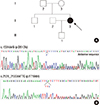1. Vieitez I, Teijeira S, Fernandez JM, San Millan B, Miranda S, Ortolano S, Louis S, Laforet P, Navarro C. Molecular and clinical study of McArdle's disease in a cohort of 123 European patients: identification of 20 novel mutations. Neuromuscul Disord. 2011; 21:817–823.
2. Dimaur S, Andreu AL, Bruno C, Hadjigeorgiou GM. Myophosphorylase deficiency (glycogenosis type V; McArdle disease). Curr Mol Med. 2002; 2:189–196.
3. Haller RG. Treatment of McArdle disease. Arch Neurol. 2000; 57:923–924.
4. Lucia A, Ruiz JR, Santalla A, Nogales-Gadea G, Rubio JC, García-Consuegra I, Cabello A, Pérez M, Teijeira S, Vieitez I, et al. Genotypic and phenotypic features of McArdle disease: insights from the Spanish national registry. J Neurol Neurosurg Psychiatry. 2012; 83:322–328.
5. Sohn EH, Kim HS, Lee AY, Fukuda T, Sugie H, Kim DS. A novel PYGM mutation in a Korean patient with McArdle disease: the role of nonsense-mediated mRNA decay. Neuromuscul Disord. 2008; 18:886–889.
6. Tsujino S, Shanske S, Goto Y, Nonaka I, DiMauro S. Two mutations, one novel and one frequently observed, in Japanese patients with McArdle's disease. Hum Mol Genet. 1994; 3:1005–1006.
7. Haller RG, Clausen T, Vissing J. Reduced levels of skeletal muscle Na+K+-ATPase in McArdle disease. Neurology. 1998; 50:37–40.
8. Clausen T, Nielsen OB. The Na+,K(+)-pump and muscle contractility. Acta Physiol Scand. 1994; 152:365–373.
9. Kazemi-Esfarjani P, Skomorowska E, Jensen TD, Haller RG, Vissing J. A nonischemic forearm exercise test for McArdle disease. Ann Neurol. 2002; 52:153–159.
10. Dyken ML, Smith DM, Peake RL. An electromyographic diagnostic screening test in McArdle's disease and a case report. Neurology. 1967; 17:45–50.
11. Lorenzoni PJ, Lange MC, Kay CS, Scola RH, Werneck LC. Motor nerve conduction study in McArdle disease: case report. Arq Neuropsiquiatr. 2005; 63:874–877.
12. Clarkson PM, Hubal MJ. Exercise-induced muscle damage in humans. Am J Phys Med Rehabil. 2002; 81:S52–S69.
13. Lucia A, Nogales-Gadea G, Pérez M, Martín MA, Andreu AL, Arenas J. McArdle disease: what do neurologists need to know? Nat Clin Pract Neurol. 2008; 4:568–577.
14. Vissing J, Haller RG. A diagnostic cycle test for McArdle's disease. Ann Neurol. 2003; 54:539–542.
15. Haller RG, Vissing J. Spontaneous "second wind" and glucose-induced second "second wind" in McArdle disease: oxidative mechanisms. Arch Neurol. 2002; 59:1395–1402.
16. Wolfe GI, Baker NS, Haller RG, Burns DK, Barohn RJ. McArdle's disease presenting with asymmetric, late-onset arm weakness. Muscle Nerve. 2000; 23:641–645.
17. Bruno C, Cassandrini D, Martinuzzi A, Toscano A, Moggio M, Morandi L, Servidei S, Mongini T, Angelini C, Musumeci O, et al. McArdle disease: the mutation spectrum of PYGM in a large Italian cohort. Hum Mutat. 2006; 27:718.
18. Martín MA, Rubio JC, Buchbinder J, Fernández-Hojas R, del Hoyo P, Teijeira S, Gámez J, Navarro C, Fernández JM, Cabello A, et al. Molecular heterogeneity of myophosphorylase deficiency (McArdle's disease): a genotype-phenotype correlation study. Ann Neurol. 2001; 50:574–581.
19. Sugie H, Sugie Y, Ito M, Fukuda T, Nonaka I, Igarashi Y. Genetic analysis of Japanese patients with myophosphorylase deficiency (McArdle's disease): single-codon deletion in exon 17 is the predominant mutation. Clin Chim Acta. 1995; 236:81–86.






